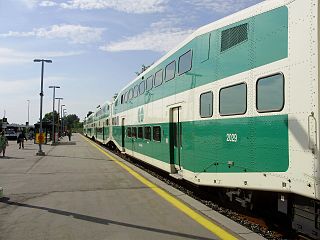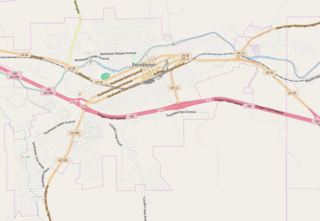
Guelph is a city in Southwestern Ontario, Canada. Known as "The Royal City", Guelph is roughly 28 km (17 mi) east of Kitchener and 100 km (62 mi) west of Downtown Toronto, at the intersection of Highway 6, Highway 7 and Wellington County Road 124. It is the seat of Wellington County, but is politically independent of it. The city is built on the traditional territory of the Mississaugas of the Credit First Nation.

Cambridge is a city in the Regional Municipality of Waterloo, Ontario, Canada. It is located at the confluence of the Grand and Speed rivers. Cambridge was formed in 1973 by the amalgamation of Galt, Preston, Hespeler, the settlement of Blair and a small portion of surrounding townships.

Vaughan is a city in Ontario, Canada. It is located in the Regional Municipality of York, just north of Toronto. Vaughan was the fastest-growing municipality in Canada between 1996 and 2006 with its population increasing by 80.2% during this time period and having nearly doubled in population since 1991. It is the fifth-largest city in the Greater Toronto Area, and the 17th-largest city in Canada.

The Regional Municipality of York, also called York Region, is a regional municipality in Southern Ontario, Canada, between Lake Simcoe and Toronto. It replaced the former York County in 1971, and is part of the Greater Toronto Area and the inner ring of the Golden Horseshoe. The regional government is headquartered in Newmarket.

Mohawk College of Applied Arts and Technology is a public college of applied arts and technology located in Hamilton, Ontario, Canada. It has three main campuses: the Fennell Campus on the Hamilton Mountain, the Stoney Creek Campus in Stoney Creek, and the Mohawk-McMaster Institute for Applied Health Sciences at McMaster University. As of 2014 more than 1000 faculty instruct roughly 12,500 full-time students, 4,000 apprentices, 46,000 continuing education registrants and 1,800 international students studying in more than 130 post-secondary and apprenticeship programs. Since its founding in 1966, over 115,000 students have graduated from Mohawk College.

Canada's Wonderland is a 134-hectare (330-acre) theme park located in Vaughan, Ontario, a suburb approximately 25 kilometres (16 mi) north of Downtown Toronto. Opened in 1981 by the Taft Broadcasting Company and The Great-West Life Assurance Company as the first major theme park in Canada, it remains the country's largest. The park, currently owned by Cedar Fair, has been the most visited seasonal amusement park in North America for several consecutive years. As a seasonal park, Canada's Wonderland is open daily from May to Labour Day, with weekend openings in late April and after Labour Day until end of October or early November. Halloween Haunt is open until October 31st at midnight early November. due to the transition between Halloween Haunt and Winterfest. With seventeen roller coasters, Canada's Wonderland is ranked second in the world by number of roller coasters, after Six Flags Magic Mountain, and tied with Cedar Point. The 134-hectare (330-acre) park includes an 8-hectare (20-acre) water park named Splash Works. The park holds Halloween Haunt, a Halloween-themed event, each fall, as well as special events throughout the season, including various food festivals, as well as "Celebration Canada", a month-long Canada Day festival, among others. Beginning in 2019, the park launched WinterFest, a holiday-themed event that would extend the park's operating season to late December.
Gregory Samuel Sorbara is a former politician in Ontario, Canada. He was a Liberal member of the Legislative Assembly of Ontario from 1985 to 1995, and again from 2001 to 2012 who represented ridings north of Toronto in the city of Vaughan. Sorbara served as a cabinet minister in the governments of David Peterson and Dalton McGuinty.

The Centre for Addiction and Mental Health, is a psychiatric teaching hospital located in Toronto and ten community locations throughout the province of Ontario, Canada. The hospital was formed in 1998 from the amalgamation of four separate institutions, the Queen Street Mental Health Centre, the Clarke Institute of Psychiatry, the Addiction Research Foundation and the Donwood Institute. It is Canada's largest mental health teaching hospital, and the only stand-alone psychiatric emergency department in Ontario. CAMH has 90 distinct clinical services across inpatient, outpatient, day treatment, and partial hospitalization models. CAMH has been the site of major advancements in psychiatric research, including the discovery of the Dopamine receptor D2 by Dr. Philip Seeman in 1974 and the development of the Clinical Institute Withdrawal Assessment for Alcohol (CIWA-Ar).

Woodbridge is a large suburban community in the City of Vaughan, just north of Toronto in Southern Ontario. Situated west of Highway 400 and east of Highway 50, north of Steeles Avenue, and generally south of Major Mackenzie Drive West. It was once an independent town before being amalgamated with nearby communities to form the city in 1971. Its traditional downtown core is the Woodbridge Avenue stretch between Islington Avenue and Kipling Avenue north of Highway 407.

Barrie is one of the seven train lines of the GO Transit system in the Greater Toronto Area, Ontario, Canada. It extends from Union Station in Toronto in a generally northward direction to Barrie, and includes ten stations along its 101.4 kilometres (63.0 mi) route. From 1982 to 1990 and again from 1993 to 2007, it was known as the Bradford line, named after its former terminus at Bradford Station until the opening of Barrie South Station.

Maple is a high-growth suburban community, part of the city of Vaughan, Ontario in York Region, northwest of Toronto, Ontario. As an unincorporated area, it does not have clearly defined geographic boundaries, but it grew around the former village of Maple, centred at the intersection of Major Mackenzie Drive and Keele Street in Vaughan.

Queensway Carleton Hospital (QCH) is a 264-bed hospital located in the west end of Ottawa, Ontario, Canada that delivers short-term primary and secondary health care.

Mackenzie Richmond Hill Hospital is a hospital in Richmond Hill, Ontario, Canada and one of three in York Regional Municipality. Mackenzie Health in Richmond Hill is part of the Local Health Integration Network (LHIN) Hospital Partnerships.
Michael Di Biase is a former Regional Councillor, deputy mayor and mayor of Vaughan, Ontario, an exurb of Toronto, Ontario, Canada. He was first elected to the city's council in 1986. Following the death of Mayor Lorna Jackson in 2002, Di Biase was appointed acting mayor by virtue of his position as senior regional councillor. In the 2003 municipal election, Di Biase won his first official term as mayor.

Milton District Hospital is a community hospital built on 40 acres (16 ha) of land, located in Milton, Ontario, Canada. It is operated by Halton Healthcare Services, an organization which also operates Oakville-Trafalgar Memorial Hospital and Georgetown Hospital.

The Radcliffe Observatory Quarter (ROQ) is a major University of Oxford development project in Oxford, England, in the estate of the old Radcliffe Infirmary hospital. The site, covering 10 acres is in central north Oxford. It is bounded by Observatory Street and Green Templeton College to the north, the Woodstock Road to the east, Somerville College to the south, and Walton Street to the west. The project and the new university area is named after the grade I listed Radcliffe Observatory to the north east of the site, now the centrepiece of Green Templeton College, which is intended to form the visual centrepiece of the project.
Alfredo "Fred" De Gasperis was an Italian-Canadian billionaire developer, and contractor. He was the founder of Condrain, a sewer and watermain contractor based in Concord, Ontario, Canada, and Metrus Development, a development company based in Vaughan, Ontario. In 2012, his net worth was estimated at $1.41 billion.

St. Anthony Hospital is an acute care hospital in Pendleton in the U.S. state of Oregon. The 25-bed facility, licensed for 49 beds, is a level 4 trauma center. Opened in 1902, it is part of the Catholic Health Initiatives and is accredited by the Joint Commission. The new campus sits along U.S. Route 395 on the south side of the city.
Viva Silver is a bus rapid transit route planned by York Region Transit to operate in Regional Municipality of York, Ontario, Canada. It is expected to begin service in 2022 as part of the Viva Rapid Transit service, after the opening of the Vaughan Metropolitan Centre subway station on the Spadina extension of the Line 1 Yonge–University subway in Toronto.
Mackenzie Health is a company based in Richmond Hill, Ontario, Canada that provides health care services in southern York Region. It operates a hospital system that includes the Mackenzie Richmond Hill Hospital in Richmond Hill, and will include the Mackenzie Vaughan Hospital in Vaughan currently under construction and expected to open in 2020.
















